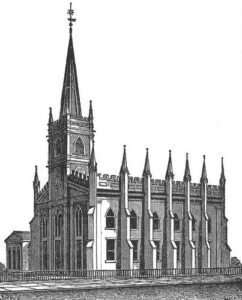Memorializing Morgan: Family, Death, and Posterity

Lewis H. Morgan Mausoleum in Mt. Hope Cemetery, ca. 1931. From the Albert R. Stone Negative Collection, Rochester Museum & Science Center, Rochester, N.Y.
There is neither a statue of Lewis Henry Morgan nor any similar memorial to him in Rochester, but his family mausoleum is a substantial monument. Located in Mount Hope Cemetery, the tomb was constructed following the deaths of Morgan’s two young daughters within three weeks of each other in 1862. Morgan carefully designed it with the help of local architects Henry Searle and Son. At the time of its completion, the structure was one of the most impressive and expensive in the cemetery. The tomb testifies not only to Morgan’s wealth, but also to his deep commitments to family and friends.
Family Background
Born in 1818, Morgan grew up in the village of Aurora, New York. His grandfather had received land in the area in recognition of his service in the Revolutionary War and migrated from New London, Connecticut, where Morgan’s ancestors had lived since 1648. Morgan was one of eight children born to Harriet Steele (1785-1854), Jedidiah Morgan’s (1774-1826) second wife. Jedidiah died when Morgan was only eight years old, leaving the boy to be raised by his mother and older siblings. In 1838, Morgan left Aurora for Union College in Schenectady, New York, where he studied Latin and Greek. After graduation, he returned to Aurora to study law.

The Morgan family residence at 124 South Fitzhugh Street (right) in 1923. From Rochester Historical Society, Publication Fund Series 2 (1923).
Morgan moved to Rochester in 1844 and practiced law with his friend and Union College classmate, George F. Danforth. Morgan married Mary Elizabeth Steele (1819-1883), his first cousin, in 1851. Mary’s inheritance enabled her to buy a row house on Fitzhugh Street in 1854, just six years after married women were allowed by law to own property in New York State. The Morgans lived in this house for the rest of their lives, raising a son and two daughters there. Lemuel Steele Morgan (1853-1905) was dependent on family members his entire life and had no children. Mary Elizabeth Morgan (1855-1862) was six years old and Helen King Morgan
(1860- 1862) was two years old when they contracted scarlet fever and died. Morgan, who was away on a research trip up the Missouri River at the time, reported that the news of his daughters’ deaths left him “a miserable and destroyed man.” Morgan planned to include an image of the mausoleum along with a long dedication to his daughters in his 1871 book, Systems of Consanguinity and Affinity of the Human Family, but the publisher rejected the plan as inappropriate for a scientific treatise.

First Presbyterian Church, 1838. Reproduced from a wood engraving in Henry O’Reilly, Sketches of Rochester (1838).
A Resting Place for Family and Friends
Morgan’s wish was that his entire family, including grandchildren, brothers, sisters, and even several friends, would be offered a place in his mausoleum. Beginning with his daughters, all the members of Morgan’s immediate family were eventually interred there. Gerard and Ellen Arink, longtime friends of the Morgans, are buried just outside of the tomb. Morgan had also offered space for the daughter of his close friend and First Presbyterian pastor, the Reverend Joshua Hall McIlvaine, but McIlvaine declined the kind gesture. Morgan had great respect for the Reverend McIlvaine, to whom he dedicated his 1877 book, Ancient Society, “in recognition of his genius and learning/and in appreciation of his friendship.”
In 1950, Morgan’s namesake Lewis Henry Morgan, a grandnephew who lived in Brighton, New York, was the last person interred in the mausoleum. The mausoleum is still an imposing presence, but the sandstone from which it was constructed has badly eroded. Plans are being made for stabilizing and restoring the tomb.

